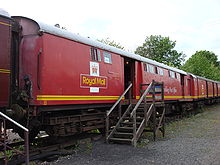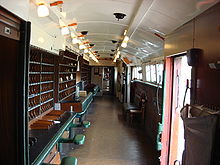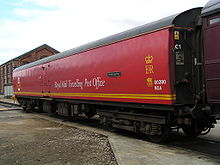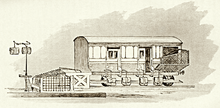- Travelling Post Offices in the United Kingdom
-
 TPO at the Colne Valley Railway
TPO at the Colne Valley Railway British Rail TPO vehicle NSA 80390 on display at Doncaster Works open day on 27 July 2003. This type of vehicle, based on the British Rail Mark 1 coach, was the final design of TPO vehicle used in the United Kingdom.
British Rail TPO vehicle NSA 80390 on display at Doncaster Works open day on 27 July 2003. This type of vehicle, based on the British Rail Mark 1 coach, was the final design of TPO vehicle used in the United Kingdom.
A Travelling Post Office (TPO) was a type of mail train in the UK where the post was sorted en-route. The last Travelling Post Office services were ended on 9 January 2004, with the carriages used now sold for scrap or to preservation societies.
Contents
Carriage of mail by train
Following an agreement in 1830, made between the General Post Office and the Liverpool and Manchester Railway (L&MR), mail had been carried by train in Great Britain, between Liverpool and Manchester, via the L&MR.[1] The passing of the Railways (Conveyance of Mails) Act 1838 required railway companies to carry mail, by ordinary or special trains, as required by the Post Master General; however this act did not set the charges for such services.[1]
These special trains eventually became Travelling Post Offices (TPOs). TPOs were employed in many British Commonwealth countries;[2] and the Army Post Office had its own TPOs.
TPOs were equipped with letter boxes so that mail could be posted whilst the train stood at a station. The post-marks from TPOs are valued by philatelists.
History
Mail was first sorted on a moving train in January 1838, in a converted horse-box, on England's Grand Junction Railway. It was carried out at the suggestion of Frederick Karstadt, a General Post Office surveyor.[3] Karstadt's son was one of two mail clerks who did the sorting.[4] In 1845 the service was extended via Derby to Newcastle upon Tyne by the Midland Railway; and soon after reached Scotland.[5]
The first special postal train was operated by the Great Western Railway between London and Bristol. The inaugural train ran on 1 February 1855, leaving Paddington station at 20:46, and arriving at Bristol at 00:30. In 1866, apparatus for picking up and setting down mailbags without stopping was installed at Slough and Maidenhead.
Post-privatisation of British Rail
After the privatisation of British Rail in the mid 1990s, British TPOs were operated by Rail Express Systems, and their successor EWS. Royal Mail decided to suspend all transportation of mail by rail in 2003.[6] The last TPO services went out on 9 January 2004, ending the sorting of mail on trains in the UK.[citation needed] Eighty percent of the sorters took early retirement, rather than retrain for other roles.[citation needed]
However, Royal Mail did restore the movement of some already-sorted letters by rail in time for the Christmas season that year, contracting with EWS's competitor GB Railfreight to resume bulk transfer services along the West Coast Main Line between its mail terminals at London (Willesden), Warrington and Glasgow (Sheildmuir) using the dedicated Class 325 electric multiple units that had been in operation since 1996. In 2009 the contract for these mail trains was transferred to EWS's successor DB Schenker Rail. For flexibility Royal Mail has preserved rail access to its distribution centres on Tyneside (Low Fell) and at Tonbridge in Kent,[6] and does occasionally send mail trains to Low Fell, for example when Newcastle Airport was closed by snow.[7]
TPO vehicles
TPOs were formed of several different types of vehicle:
- Post Office Sorting Van
- Post Office Stowage Van
- Brake Post Office Stowage Van
- Courier Vehicle
- Propelling Control Vehicle
- Brake Guard
- General Utility Van
See also
- Great Central Steam Railway - where the Travelling Post Office and Mail Exchange on the Move is recreated
- Great Train Robbery (1963) in which £2.3 million was stolen from a Glasgow to London TPO train
- Night Mail - Film and Poem about Travelling Post Office
- Railways (Conveyance of Mails) Act 1838
- Railway post office - The term for cars in North American use that served similar functions.
- SNCF TGV La Poste - French Post Office dedicated TGV sets.
- British Rail Class 325, Royal Mail EMUs used in Britain.
- London Post Office Railway, which Royal Mail used to transport mail across London on private underground tracks
References
- ^ a b Simmons, Jack; Biddle, Gordon (1997). The Oxford Companion to British Railway History From 1603 to the 1990s (1st Ed. ed.). Oxford: Oxford University Press. ISBN 0-19-211697-5. Pp 303-304.
- ^ Poole, L.G. (1969). "The Travelling Post Offices of Victoria: 1865 - 1912", In: Australian Railway Historical Society Bulletin, June, 1969, Pp127-139.
- ^ White, John H., Jr. (1978). The American Railroad Passenger Car. Baltimore and London: Johns Hopkins University Press. p. 473. ISBN 0-8018-1965-2.
- ^ Johnson, Peter. (1985). The British Travelling Post Office. Surrey: Ian Allan Publishing. p. 13. ISBN 0-711-01459-0.
- ^ Billson, P., (1996) Derby and the Midland Railway Derby: Breedon Books
- ^ a b Written statement by Royal Mail (Document FOR 105), House of Commons Transport Select Committee, September 2003
- ^ Railforums posting, 29 December 2010
External links
- The Travelling Post Office, British Postal Museum and Archive
- Travelling Post Offices, Allan Yeo website.
- Parcels and Post Office Traffic, Mike Smith 'Goods and Not So Goods' website.
- Mail by Rail, John Chenery 'Light Straw' website.
- Friends of M30272M TPO Group, Nene Valley Railway (via archive.org)
- Schedule of mail trains operating from London (Willesden) in 2002
- TPO and Seapost Society for all collectors of Rail and Ship Mail worldwide
Categories:- British railway wagons
- DB Schenker Rail (UK)
- Postal system of the United Kingdom
- Philatelic terminology
Wikimedia Foundation. 2010.



